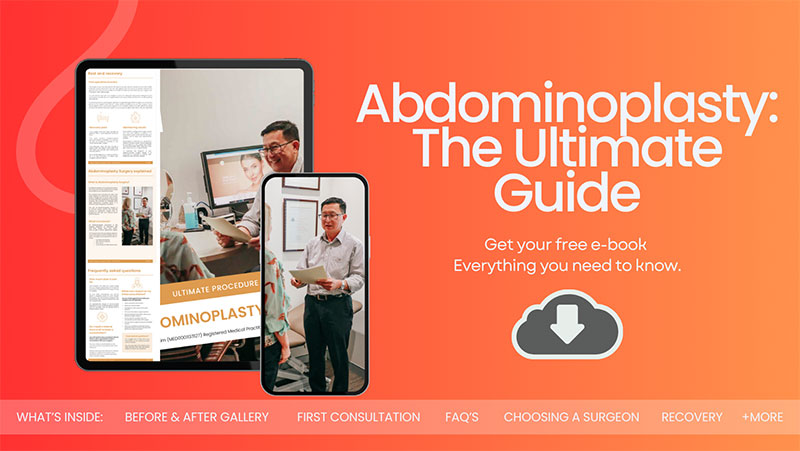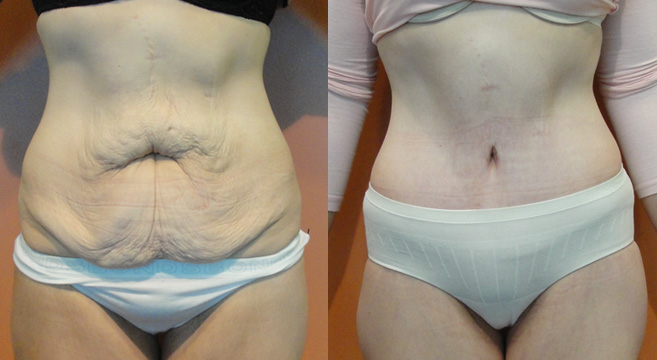Abdominoplasty to Correct Diastasis Recti after Pregnancy
When you’re pregnant, your abdominal muscles stretch to accommodate your growing baby. In some cases, these muscles don’t return to their original position after giving birth, resulting in a condition called Diastasis Recti. This term, which in Latin means “separation of the rectus,” refers to the gap that develops between the two sections of your abdominal muscles. Split muscles is a condition that can occur in women who have had multiple pregnancies, large babies, or are over the age of 35. It can lead to a protruding belly. The severity of Diastasis Recti varies, and while mild cases might improve with exercises and time, severe cases may require surgical intervention, such as an abdominoplasty.
Highly qualified and experienced specialist plastic surgeon Dr Jake Lim performs body contouring surgery, including abdominoplasty to correct diastasis recti.
Dr Lim’s 2024 Abdominoplasty Guide

Signs of Diastasis Recti
Here are the some indicators of split muscles after pregnancy:
- Visible Bulge or “Pooch”: One of the most noticeable signs is a protruding bulge in the midline of the abdomen, especially when the abdominal muscles are strained or contracted. This bulge can become more prominent when sitting up from a lying position or during other abdominal movements
- Palpable Gap: By lying on your back and gently pressing the fingers into the midline of the abdomen while lifting the head and shoulders, you might feel a gap or separation between the abdominal muscles. The width of this gap can vary among individuals
- Lower Back Pain: Due to the weakened core muscles, individuals with diastasis recti may experience chronic lower back pain. The condition can lead to an altered posture and over-reliance on back muscles, causing discomfort
- Difficulty in Performing Core Exercises: Tasks that require core strength, such as sit-ups, planks, or other abdominal exercises, may become challenging or cause discomfort
- Poor Posture: The core muscles play a vital role in maintaining an upright posture. A weakened core due to diastasis recti can result in slouching or a forward-leaning stance
- Constipation and Bloating: The weakened abdominal wall can lead to reduced support for internal organs, potentially causing digestive issues like constipation and bloating
- Pelvic Floor Dysfunction: As the abdominal and pelvic floor muscles are interconnected, diastasis recti can sometimes be accompanied by symptoms like urinary incontinence, pelvic pain, or a feeling of heaviness in the pelvic region
- Umbilical Hernia: In some cases, the separation of the muscles can lead to the development of an umbilical hernia, where a portion of the intestine or abdominal tissue pushes through the abdominal wall near the belly button
- Tenderness or Discomfort: Some individuals might feel tenderness or discomfort along the midline of the abdomen, especially when the area is touched or pressured
- Changes in Belly Button Appearance: The belly button might appear stretched, flattened, or pushed out more than usual
If you suspect you have diastasis recti based on the signs mentioned above, it’s essential to consult with your doctor or a plastic surgeon. They can provide a proper assessment and recommend suitable interventions and treatments to manage and potentially improve the condition.
Diastasis Recti Treatment Options
Diastasis recti, the separation of the rectus abdominis muscles, can be a concern for many individuals, especially postpartum women. Addressing this condition is essential for both functional and aesthetic reasons. Here are some treatment options available:
Physical Therapy
- Targeted Exercises: A physical therapist can guide patients through specific exercises designed to strengthen the transverse abdominis, the deep core muscle that supports the front of the abdomen
- Pelvic Floor Training: Since the pelvic floor and abdominal muscles are interconnected, strengthening the pelvic floor can also help in managing diastasis recti
Exercise Programs
- Postpartum Exercise Classes: Many fitness centres offer classes specifically designed for postpartum women, focusing on safely strengthening the core
- Pilates and Yoga: These disciplines emphasise core strength and can be modified to address diastasis recti, but it’s essential to work with an instructor familiar with the condition
Supportive Garments
- Abdominal Binders: These are wide compression belts that wrap around the abdomen, providing support and helping to approximate the separated muscles
- Postpartum Support Wear: Specialised postpartum shapewear can offer gentle compression to support the healing process
Abdominoplasty (Tummy Tuck)
- Abdominoplasty is a surgical procedure where excess skin and fat are removed from the abdomen, and the separated muscles are sutured together. This not only addresses diastasis recti but also provides an improved abdominal appearance
Minimally Invasive Procedures
- Endoscopic Diastasis Repair: This is a less invasive surgical option where small incisions are made, and the muscles are sutured together using an endoscope for guidance
- Radiofrequency or Ultrasound Treatments: Some newer treatments use radiofrequency or ultrasound energy to tighten the skin and stimulate collagen production, which can provide some improvement in the appearance of diastasis recti
Lifestyle Modifications
- Posture: Maintaining good posture can help reduce strain on the abdominal muscles and support healing
- Safe Lifting Techniques: Using proper techniques when lifting heavy objects can prevent exacerbating the condition
The best treatment for diastasis recti often depends on the severity of the condition, the individual’s health, and their personal preferences. When the condition is severe, the recommended treatment might include abdominoplasty.

Abdominoplasty to Correct Split Muscles after Pregnancy
Abdominoplasty, commonly known as a “tummy tuck,” is a surgical procedure that removes excess fat and skin from your abdomen and tightens the muscles in your abdominal wall. This procedure is not an alternative to weight loss; it’s a way to address issues that diet and exercise cannot fix, such as loose or sagging skin and separated muscles. It’s important to have realistic expectations about the outcome of the surgery and to discuss these with Dr Lim.
If you’re dealing with Diastasis Recti, you might have tried various exercises to close the gap between your muscles. However, when the separation is severe, exercise alone is often not enough. This is where abdominoplasty can be an effective treatment.
During an abdominoplasty, Dr Lim will make an incision in your lower abdomen, remove excess skin and fat, and stitch together the separated abdominal muscles. This not only improves the appearance of your stomach but also strengthens your abdominal wall, addressing the physical discomfort associated with Diastasis Recti.
Abdominoplasty is an invasive procedure that requires general anaesthesia. To repair the separated muscles after pregnancy, Dr Lim will make an incision from hip to hip, right above your pubic area. They’ll then lift the skin and fat away from the abdominal muscles, stitch the separated muscles back together, and remove any excess skin. This procedure typically takes between two to three hours, depending on the extent of the repair needed.
Recovery after an abdominoplasty can take several weeks. Initially, you’ll likely experience swelling, discomfort, and fatigue. Dr Lim will provide you with pain medication to manage the discomfort and instructions on how to care for your surgical wound.
You’ll also need to avoid strenuous activities for several weeks, and it may take up to six months for your body to fully heal. During this period, it’s crucial to follow Dr Lim’s advice and attend all follow-up appointments.
Benefits and Risks of Abdominoplasty
Like any surgery, abdominoplasty comes with both benefits and risks. The benefits include a flatter, firmer abdomen, improved body contour, and relief from the physical discomfort caused by Diastasis Recti.
It’s crucial to be aware of the potential risks and complications of abdominoplasty. These include infection, bleeding, poor wound healing, changes in skin sensation, and risks associated with anaesthesia. It’s essential to discuss these risks with your plastic surgeon before deciding to undergo the procedure.
Prevention and Care for Split Muscles during Pregnancy
While it’s not always possible to prevent Diastasis Recti, certain measures can help reduce the risk. These include maintaining a healthy weight during pregnancy, practicing safe exercise, and avoiding heavy lifting. After childbirth, be patient with your body and give it time to recover.
If you do develop Diastasis Recti, remember that it’s a common condition that many women experience. Always consult with your plastic surgeon to explore your treatment options.
FAQs about Diastasis Recti and Abdominoplasty

What are the causes of diastasis recti?
- Diastasis recti primarily occurs due to the stretching of the rectus abdominis muscles and the connective tissue (Linea Alba) that runs down the midline of the abdomen. The most common cause is pregnancy, as the growing uterus puts pressure on the abdominal wall, leading to muscle separation. However, it’s not exclusive to pregnant women. Other causes include rapid weight gain, performing excessive or incorrect abdominal exercises, carrying multiple pregnancies (like twins or triplets), and certain medical conditions that cause increased abdominal pressure.
What is the recovery time for abdominoplasty with diastasis recti?
- Recovery time for abdominoplasty, especially when addressing diastasis recti, varies among individuals. Generally, patients can expect to return to light daily activities within 3 weeks. Intense activities and heavy lifting should be avoided for at least 6 to 8 weeks. Full recovery, where the patient feels back to their normal self and the surgical area has healed completely, can take several months. It’s essential to follow the plastic surgeon’s post-operative care instructions and attend follow-up appointments to ensure a smooth recovery.
Is diastasis recti surgery the same with abdominoplasty?
- Not exactly. While both surgeries address the abdominal region, their primary purposes differ. Diastasis recti surgery specifically focuses on repairing the separated abdominal muscles by suturing them back together. Abdominoplasty, commonly known as a “tummy tuck,” is a more comprehensive procedure that removes excess skin and fat from the abdomen and tightens the abdominal muscles, which often includes repairing diastasis recti. So, while abdominoplasty can address diastasis recti, not all diastasis recti surgeries are full abdominoplasties.
Can I do exercises to correct diastasis recti?
- Yes, specific exercises can help improve or even correct diastasis recti, especially when the separation is mild to moderate. These exercises aim to strengthen the transverse abdominis, the deep core muscle. Examples include pelvic tilts, heel slides, and certain modified pilates movements. Keep in mind that it’s crucial to avoid exercises that can exacerbate the condition, like traditional sit-ups or crunches. Working with a physical therapist or a fitness professional knowledgeable about diastasis recti can provide guidance on the most effective and safe exercises.
Can diastasis recti cause digestive problems?
- While diastasis recti primarily affects the abdominal muscles, it can indirectly influence the organs they protect, including the digestive system. A weakened abdominal wall might lead to reduced support for the intestines and stomach, potentially causing issues like constipation, bloating, and discomfort. While diastasis recti can contribute to digestive problems, it’s not typically the sole cause. If someone with diastasis recti experiences severe or persistent digestive issues, they should consult a healthcare professional to rule out other underlying conditions.
Further Reading about Body Procedures with Dr Jake Lim
- Read Dr Lim’s Abdominoplasty Page
- Read Dr Lim’s Post Pregnancy Procedures Page
- Read Dr Lim’s Body Procedures after Weight Loss Page
- Read Dr Lim’s Liposuction Page
- Read Dr Lim’s Blog about Recovery after Tummy Tuck – Abdominoplasty
Medical References about Diastasis Recti and Abdominoplasty
- Diastasis Recti (Abdominal Separation) – Cleveland Clinic
- Abdominal Separation (Diastasis Recti) – WebMD
- Your post-pregnancy body – NHS
- Impact of Rectus Diastasis Repair on Abdominal Strength and Function
About Dr Jake Lim
Highly qualified and experienced specialist plastic surgeon Dr Jake Lim focuses on facial plastic, cosmetic breast and body contouring after significant weight loss
Dr Lim creates the best possible plastic surgery results for his Australia-wide and international patients.
Dr Lim is passionate about making sure each and every patient has access to the right information about available treatments and procedures and is able to make well-informed decisions.
At My Klinik, patient safety, education and achieving optimal results are our top priorities.




